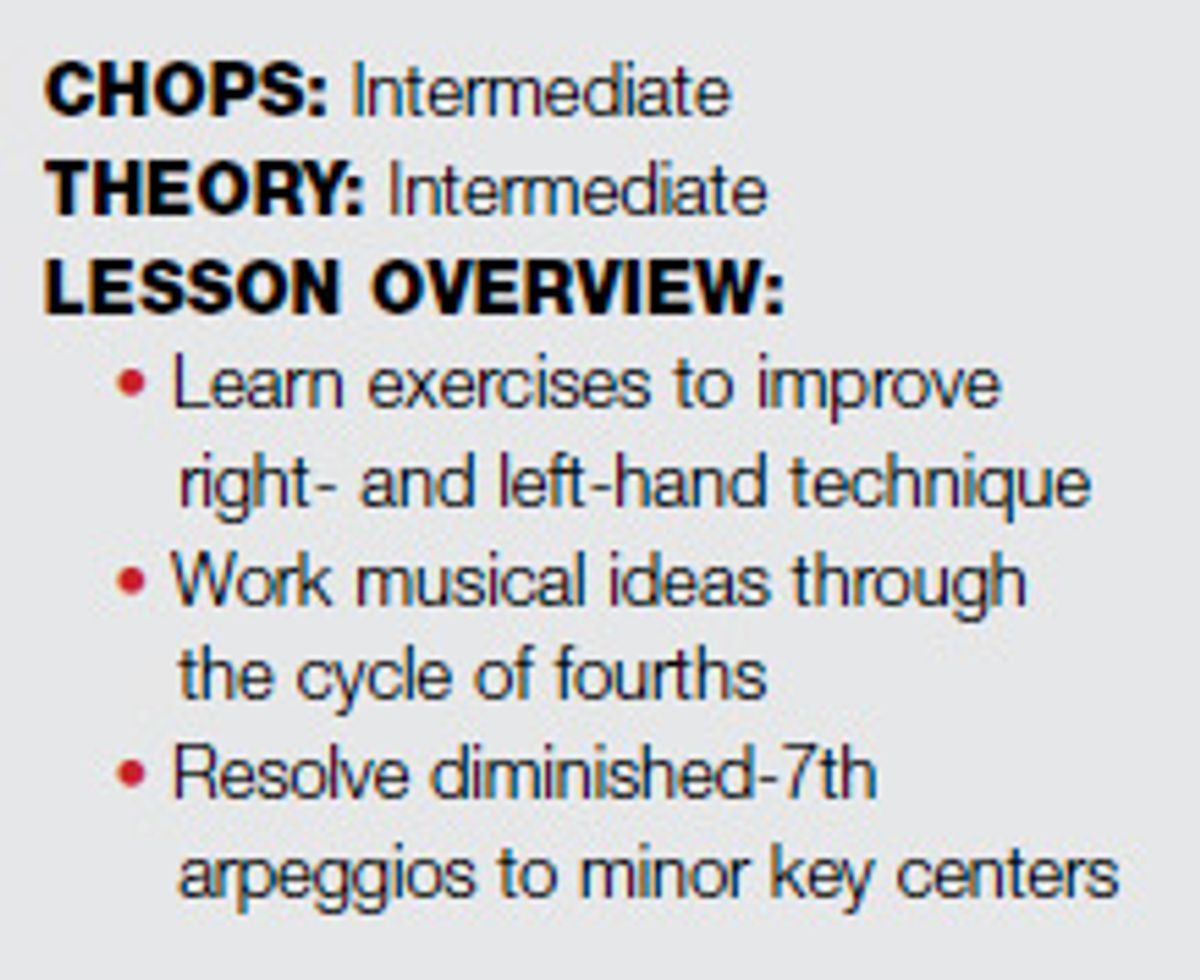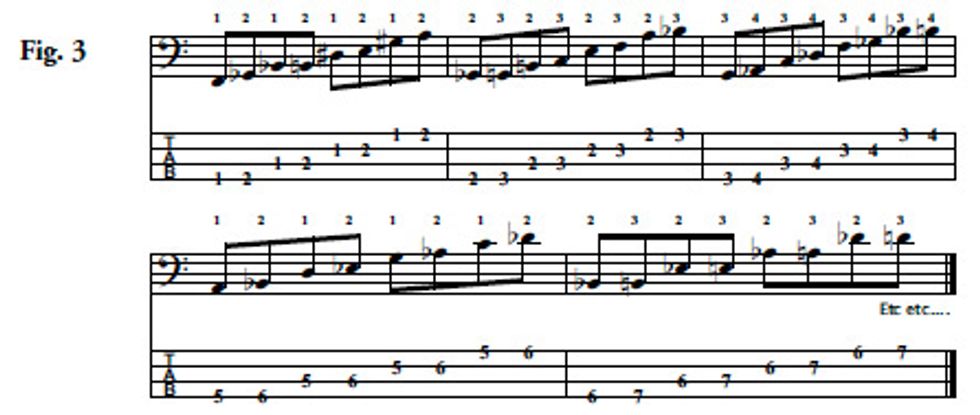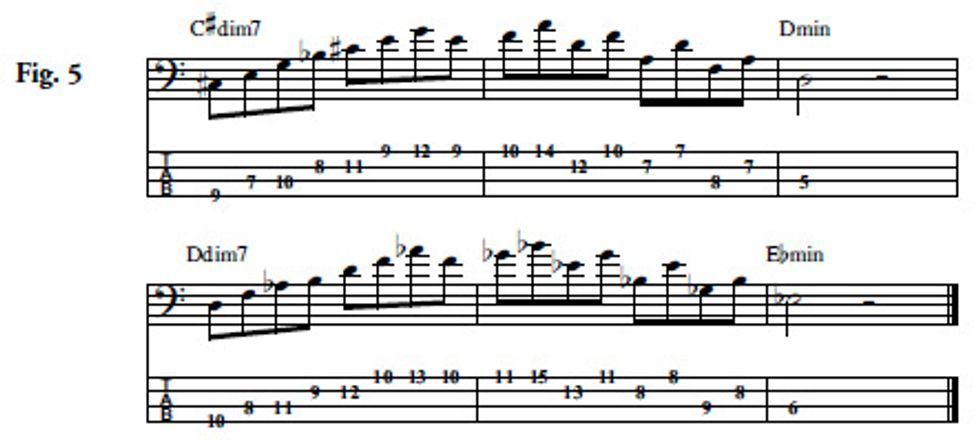
These simple ideas have helped me improve consistency in my time, sound, fluidity, and other fundamental aspects of my musicianship.
I want to share some things with you that
have been incredibly useful in my development
as a bass player over the past 15
years. The title says it all: What are the five
technique-builders you can’t live without
as a bass player? Well, by no means am I
about to tell you these are the only things
you need to work on to become a great bass
player, but these simple ideas have helped
me improve consistency in my time, sound,
fluidity, and other fundamental aspects of
my musicianship. Essentially, this is a brief
look inside my general warm-up and practice
routine. I think it’s important—no matter
what style of music you play—to have
a solid control of the fundamentals of harmony,
rhythm, and melody. The examples
in this column not only focus on these three
aspects of music, but they can really enhance
your basic command of the instrument.
Let’s start at the beginning and take a look at an exercise I’ve used for a decade or so, and continue to use to warm up whenever I pick up the bass. The major- 7th arpeggio (1–3–5–7) is the basis for Fig. 1, which is in the key of C. As with all of the practice ideas I’m laying out here, I recommend you play this example slowly at first, perhaps with a metronome if you need some enforced discipline in your routine.
or download example audio

The melodic and harmonic content in Fig. 2 is similar to Fig. 1, but this time I’m doubling up each note to really work the alternating fingers on the right hand. I find that my hands warm up at different rates when I first pick up my instrument, and by doubling up this exercise with the right hand, I give my index and middle fingers a bit more of a workout and warm them up a little quicker.
or download example audio

One of the biggest technical challenges we face as bass players or guitarists is crossing strings. It was certainly a challenge for me to become more fluent at this, and I developed a little idea you can see in Fig. 3 to help strengthen all the fingers on my left hand and make sure they all operate as well as each other. In this exercise, there should be no difference in ability from using your first and second fingers or your third and fourth fingers. Again, make sure you start this one at a slow tempo and work your way up to faster tempos. It’s a drag to dive head first into something new that your muscles aren’t used to and then get injured. We don’t want that!
or download example audio

Now I know that playing scales can be a drag, but in my experience there’s not really a way around it. It’s something I’ve done a lot and continue to do today. When I was first starting out, I found an old piano book that belonged to my father and I adapted a couple of exercises from that book for bass. In Fig. 4 we want to make some music out of these scales instead of mindlessly running them up and down the instrument. The idea is to make groupings of four-note cells out of the major scale you’re playing and really give both hands a workout. I suggest you use this one idea as a starting point for making up your own exercises out of major or minor scales.
or download example audio

The last idea I want to put forward to close out this column is a little more advanced, but totally playable by anyone out there if you spend just a little time getting the basic idea under your fingers. It’s not only a great technique builder, but it also deals with resolving a diminished-7th arpeggio (1–b3–b5–bb7) to a minor root. You’ll notice that Fig. 5 starts out with an ascending C# diminished-7th arpeggio and then descends with a D minor arpeggio.
or download example audio

In terms of harmony, I’m thinking about the C#dim7 functioning as an altered-dominant chord without the root (in this case, you could think of it as A7b9 and play all of those notes over an A pedal) with the resolution establishing the root tonality of D minor. This gives me a way of resolving from the dominant to the root with a movement of just a half-step (C#–D) in the bass. It also gives me a slightly different way to think about a straightforward minor arpeggio, and get my fingers on the left hand working outside of their comfort zone with some pretty similar harmonic material.
I hope you can find some ideas in here that help your playing—they’ve certainly helped me improve. And I hope these examples can serve as a starting point for you to create similar exercises that suit the way you play.
 Janek Gwizdala
Janek Gwizdala
Janek Gwizdala has been on the international music scene for more than 15 years. His touring, recording, and production credits range from being musical director for V.V. Brown and Delta Goodrem, to working with such jazz legends as Mike Stern, Pat Metheny, Randy Brecker, Hiram Bullock, and Wayne Krantz. Janek has been a clinician the world over, giving lectures at leading music schools and conservatories. For more information, visit janekgwizdala.com.
Let’s start at the beginning and take a look at an exercise I’ve used for a decade or so, and continue to use to warm up whenever I pick up the bass. The major- 7th arpeggio (1–3–5–7) is the basis for Fig. 1, which is in the key of C. As with all of the practice ideas I’m laying out here, I recommend you play this example slowly at first, perhaps with a metronome if you need some enforced discipline in your routine.
or download example audio

The melodic and harmonic content in Fig. 2 is similar to Fig. 1, but this time I’m doubling up each note to really work the alternating fingers on the right hand. I find that my hands warm up at different rates when I first pick up my instrument, and by doubling up this exercise with the right hand, I give my index and middle fingers a bit more of a workout and warm them up a little quicker.
or download example audio

One of the biggest technical challenges we face as bass players or guitarists is crossing strings. It was certainly a challenge for me to become more fluent at this, and I developed a little idea you can see in Fig. 3 to help strengthen all the fingers on my left hand and make sure they all operate as well as each other. In this exercise, there should be no difference in ability from using your first and second fingers or your third and fourth fingers. Again, make sure you start this one at a slow tempo and work your way up to faster tempos. It’s a drag to dive head first into something new that your muscles aren’t used to and then get injured. We don’t want that!
or download example audio

Now I know that playing scales can be a drag, but in my experience there’s not really a way around it. It’s something I’ve done a lot and continue to do today. When I was first starting out, I found an old piano book that belonged to my father and I adapted a couple of exercises from that book for bass. In Fig. 4 we want to make some music out of these scales instead of mindlessly running them up and down the instrument. The idea is to make groupings of four-note cells out of the major scale you’re playing and really give both hands a workout. I suggest you use this one idea as a starting point for making up your own exercises out of major or minor scales.
or download example audio

The last idea I want to put forward to close out this column is a little more advanced, but totally playable by anyone out there if you spend just a little time getting the basic idea under your fingers. It’s not only a great technique builder, but it also deals with resolving a diminished-7th arpeggio (1–b3–b5–bb7) to a minor root. You’ll notice that Fig. 5 starts out with an ascending C# diminished-7th arpeggio and then descends with a D minor arpeggio.
or download example audio

In terms of harmony, I’m thinking about the C#dim7 functioning as an altered-dominant chord without the root (in this case, you could think of it as A7b9 and play all of those notes over an A pedal) with the resolution establishing the root tonality of D minor. This gives me a way of resolving from the dominant to the root with a movement of just a half-step (C#–D) in the bass. It also gives me a slightly different way to think about a straightforward minor arpeggio, and get my fingers on the left hand working outside of their comfort zone with some pretty similar harmonic material.
I hope you can find some ideas in here that help your playing—they’ve certainly helped me improve. And I hope these examples can serve as a starting point for you to create similar exercises that suit the way you play.
 Janek Gwizdala
Janek GwizdalaJanek Gwizdala has been on the international music scene for more than 15 years. His touring, recording, and production credits range from being musical director for V.V. Brown and Delta Goodrem, to working with such jazz legends as Mike Stern, Pat Metheny, Randy Brecker, Hiram Bullock, and Wayne Krantz. Janek has been a clinician the world over, giving lectures at leading music schools and conservatories. For more information, visit janekgwizdala.com.

